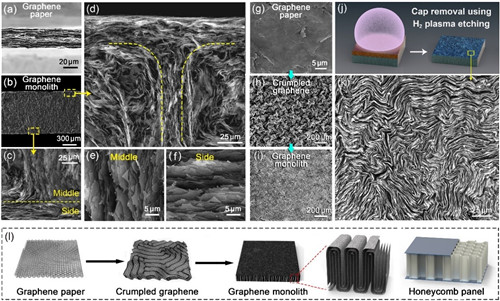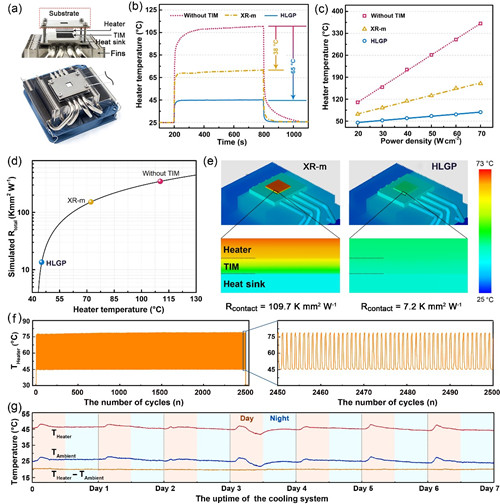Functional Carbon Materials Research Group at the Ningbo Institute of Materials Technology and Engineering (NIMTE), Chinese Academy of Sciences (CAS), has developed a graphene thermal interface material (TIM) composed of mainly vertically aligned graphene. Thanks to the ultra-high through-plane thermal conductivity and low compressive modulus, the resultant graphene TIM may satisfy the demanding heat dissipation requirements for next-generation high-power integrated circuits (ICs), in cooperation with researchers at the University of Nevada in USA. The study was published in ACS Nano.
With the prosperous technology evolution for miniaturization and dense integration of semiconductor devices, the heat transfer problem has drawn great concern. Statistics indicated that a 10 – 15 °C temperature rise in electronic components may lead to a 50% reduction in the device's lifespan. Therefore, heat transfer in electronics has become the primary issue hampering the performance and shortening the lifespan. As an efficient method to address this issue, thermal interface materials (TIMs) are applied to fill the microgaps and bridge between the heat generating components (IC chips etc.) and the sink/spreader. TIMs are desired to have both high through-plane thermal conductivity and high compressibility, which are difficult to satisfy simultaneously for most materials, like hard metals and soft silicones.
To address this problem, researchers has developed a soft graphene TIM with a low compressive modulus of 0.87 Mpa, much smaller than that of silicone-based composites (2 – 10 MPa), and an ultrahigh through-plane thermal conductivity of 143 W m-1 K-1 , a thousand times as high as the silicones and exceeding that of many metals.
The samples were made by a feasible machining-based process based on a self-developed automation equipment, which manipulated the stacked architecture of graphene paper from horizontal to vertical orientation (Fig. 1). The obtained graphene TIM showed a hierarchical microstructure composed of mainly vertically aligned graphene in the middle, and a thin cap of horizontal graphene layers at both top and bottom sides (Fig. 2).
According to the TIM performance measurement (Fig. 3), the system cooling efficiency with the graphene as TIM was ~3 times as high as that of state-of-the-art commercial thermal pads (~17 W m-1 K-1), with a decrease of the heater temperature by 65 °C (the samples) versus 38 °C (counterparts), indicating a significant improvement in the heat dissipation capacity of electronics. Moreover, due to the all-inorganic composition of graphene, the obtained graphene TIM showed an excellent thermal cycling stability (< 0.5% decay after 2,500 cycles) and a wide operating temperature range in air (-196 – 500 °C), which were both far beyond those of silicone-based thermal pads (-50 – 200 °C), suggesting potential heat transfer applications in extreme environments.
This technical breakthrough has not only provided an efficient and scalable method for the development of graphene sheets with superlative thermal transfer properties, but also offered novel insight into the construction of others two-dimensional materials (e.g., BN nanosheets and Mxenes) and vertically aligned architectures, as well as the extension of their real-world applications.
This work was supported by various projects and programs including the National Key R&D Program of China (No. 2017YFB0406000), the Strategic Priority Research Program of the Chinese Academy of Sciences (No. XDA22000000), Scientific Instrument Developing Project of the Chinese Academy of Sciences (No. YZ201640), Science and Technology Major Project of Ningbo (No. 2016S1002 and No. 2016B10038), International S&T Cooperation Program of Ningbo (No. 2017D10016) , the Chinese Academy of Sciences for Hundred Talents Program, Chinese Central Government for Thousand Young Talents Program, and 3315 Program of Ningbo.

Fig. 1 Schematic illustration presenting the fabrication process of graphene monolith from graphene paper. (Image by DAI Wen)

Fig. 2 The microstructural variations during mechanical processing: Cross-sectional SEM images of (a) pristine graphene paper and (b) the monolith. (c) (d)The detailed microstructure close to the monolith surface. (e) (f) The regions enlarged from (c) exhibiting distinct graphene alignments. (g–i) Top-view of the corresponding morphological changes from (a) to (b). (j) An illustration and (k) top-view SEM image showing the vertically aligned graphene underneath the cap. (l) Schematic illustrating the structural change of the graphene based on the proposed. (Image by DAI Wen)

Fig. 3 (a) Schematic configuration of TIM performance measurement system. Temperature evolution of ceramic heater as a function of (b) the heating time at an applied power of 20 W cm-2 and (c) various power densities at steady state. (d) The calculated total thermal resistance (Rtotal) versus saturated heater temperature in (b). (e) The comparison of heat dissipation capability based on fluid dynamics simulation. (f) Good thermal shock stability in cyclic heating/cooling tests, and (g) good thermal durability of HLGP in a long-term TIM performance test (7 days). (Image by DAI Wen)
Contact
DAI Wen
Ningbo Institute of Materials Technology and Engineering
E-mail: daiwen@nimte.ac.cn

